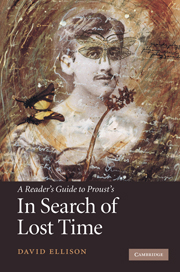Book contents
- Frontmatter
- Contents
- List of illustrations
- Preface
- Acknowledgements
- Chronology
- Introduction: At the threshold of Proust's novel
- 1 Du Côté de chez Swann [The Way by Swann's]
- 2 A l'Ombre des jeunes filles en fleurs [In the Shadow of Young Girls in Flower]
- 3 Le Côté de Guermantes [The Guermantes Way]
- 4 Sodome et Gomorrhe [Sodom and Gomorrah]
- 5 La Prisonnière [The Prisoner] and Albertine disparue [The Fugitive]
- 6 Le Temps retrouvé [Finding Time Again]
- Notes
- Select bibliography
- Index
5 - La Prisonnière [The Prisoner] and Albertine disparue [The Fugitive]
Published online by Cambridge University Press: 05 August 2012
- Frontmatter
- Contents
- List of illustrations
- Preface
- Acknowledgements
- Chronology
- Introduction: At the threshold of Proust's novel
- 1 Du Côté de chez Swann [The Way by Swann's]
- 2 A l'Ombre des jeunes filles en fleurs [In the Shadow of Young Girls in Flower]
- 3 Le Côté de Guermantes [The Guermantes Way]
- 4 Sodome et Gomorrhe [Sodom and Gomorrah]
- 5 La Prisonnière [The Prisoner] and Albertine disparue [The Fugitive]
- 6 Le Temps retrouvé [Finding Time Again]
- Notes
- Select bibliography
- Index
Summary
The twin penultimate volumes of A la recherche du temps perdu were published posthumously, La Prisonnière (subtitled Sodome et Gomorrhe III) in 1923, and Albertine disparue in 1924. This section of the novel presents significant interpretative problems for its reader, in two separate but equally important ways. First, because Proust died before he was able to make final corrections and strategic structural decisions on the length and thematic content of this complex episode, the status of the text – its authenticity as the expression of the author's will and decision-making – remains very much in doubt. Second, the universe in which the action of these two volumes unfolds is significantly reduced in scope from the previous ones. Novelistic verisimilitude is often abandoned in favor of minute and obsessive psychological analysis centered on the claustrophobic arena in which the narrator at first cohabits with Albertine, then agonizes over her disappearance. It is as if, in a sudden discontinuous jump, we were moving from a kaleidoscopic Balzacian social world to strange and spare territories that point to the reduced imaginative space of Samuel Beckett.
At the highest level of generality, La Prisonnière and Albertine disparue constitute a coherent and symmetrical whole, in that the first volume, as its title implies, describes the “imprisonment” of its female protagonist by the narrator, while its continuation details her escape and death. The original designation of the second volume, La Fugitive, drew attention to this dramatic symmetry.
- Type
- Chapter
- Information
- A Reader's Guide to Proust's 'In Search of Lost Time' , pp. 136 - 161Publisher: Cambridge University PressPrint publication year: 2010



